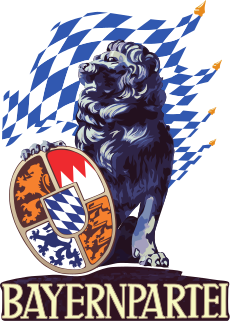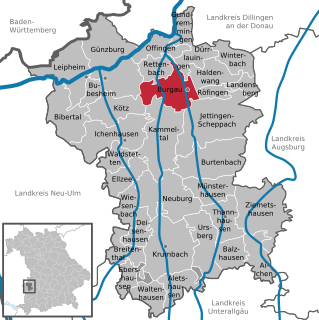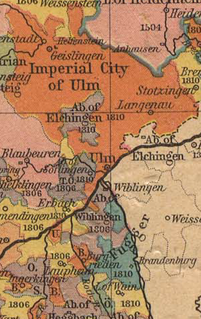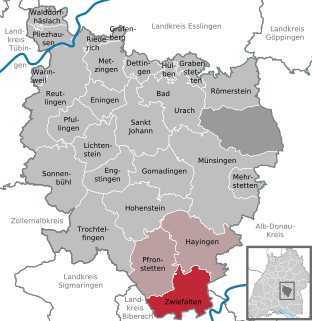
Swabia is one of the seven administrative regions of Bavaria, Germany.

The Bavaria Party is an autonomist and regionalist political party in the state of Bavaria. It was founded in 1946 and describes itself as patriotic Bavarian, advocating Bavarian independence within the European Union. Together with the Christian Social Union (CSU), it can be seen as an heir to the Bavarian People's Party (BVP) which existed prior to the Nazi takeover. The party is a member of the European Free Alliance.

Ottobeuren is a Benedictine abbey, located in Ottobeuren, near Memmingen in the Bavarian Allgäu, Germany.

Irsee Abbey, also the Imperial Abbey of Irsee, was a Benedictine abbey located at Irsee near Kaufbeuren in Bavaria. The self-ruling imperial abbey was secularized in the course of the German mediatization of 1802–1803 and its territory annexed to Bavaria. The buildings of the former abbey now house a conference and training centre for Bavarian Swabia.

Burgau is a town in the district of Günzburg in Swabia, Bavaria. Burgau lies on the river Mindel, and has a population of just under 10,000.
Wettenhausen Abbey was an Imperial Abbey of Augustinian Canons until its secularization in 1802-1803. Being one of the 40-odd self-ruling Imperial Abbeys of the Holy Roman Empire, Wettenhaussen Abbey was a virtually independent state. Its abbot had seat and voice in the Imperial Diet, where he sat on the Bench of the Prelates of Swabia. At the time of secularization, the Abbey's territory covered 56 square kilometers and it had about 5,400 subjects.

Elchingen Abbey was a Benedictine monastery in Oberelchingen in Bavaria, Germany, in the diocese of Augsburg.

Banz Abbey, now known as Banz Castle, is a former Benedictine monastery, since 1978 a part of the town of Bad Staffelstein north of Bamberg, Bavaria, southern Germany.

Westerstetten is a village in the district of Alb-Donau in Baden-Württemberg in Germany.
St. Mang's Abbey, Füssen or Füssen Abbey was a Benedictine monastery in Füssen in Bavaria, Germany. It was founded in the 9th century, and dissolved during the post-Napoleonic secularisation of Bavaria.

St. Ulrich's and St. Afra's Abbey, Augsburg is a former Benedictine abbey dedicated to Saint Ulrich and Saint Afra in the south of the old city in Augsburg, Bavaria.

Oberschönenfeld Abbey is a Cistercian nunnery in Gessertshausen in Bavaria, Germany.

Zwiefalten is a municipality in the district of Reutlingen, Baden-Württemberg, Germany located halfway between Stuttgart and Lake Constance. The former Zwiefalten Abbey dominates the town. The former monastery is considered one of the finest examples of late Baroque art.

Höchberg is a municipality in the district of Würzburg in Bavaria, Germany. Höchberg borders, in the east, directly on the city of Würzburg. Höchberg consists of two main urban areas: Altort and Hexenbruch. Residential construction areas have been added in recent years, for example "Mehle" and " Mehle II".
Roggenburg Abbey is a Premonstratensian canonry in Roggenburg near Neu-Ulm, Bavaria, in operation between 1126 and 1802, and again from its re-foundation in 1986. Since 1992 it has been an independent priory of Windberg Abbey in Lower Bavaria. The monastery manages a training centre and a museum, and is widely known for its almost unchanged Baroque building and the organ concerts that are held in the church.

Gau Swabia formed on 1 October 1928, was an administrative division of Nazi Germany in Swabia, Bavaria, from 1933 to 1945. From 1928 to 1933, it was the regional subdivision of the Nazi Party in that area.
The Federal Agency for Civic Education is a German federal government agency responsible for promoting civic education. It is subordinated to the Federal Ministry of the Interior, Building and Community. Thomas Krüger has served as President of the agency since 2000. The modern agency was established in West Germany in 1952 by the Adenauer government to counteract communism during the Cold War, but it has its roots in earlier government agencies dating back to the First World War.
Sevim Çelebi-Gottschlich is a former German Politician. She served from 1987 to 1989 in the Abgeordnetenhaus of Berlin, the state parliament of Berlin.

The Party of Humanists is a minor political party in Germany that first participated in the 2017 federal election.

The Nordenstadt Memorial is a memorial to the Nordenstadt Jews murdered in the Holocaust. It was inaugurated in 1994 in front of the former town hall. This is the place from which the deportation of the Jews from Nordenstadt took place. On the green space on the corner of Heerstraße and Stolberger Strasse, the artist Marc van den Broek designed 15 metal steles of different heights. 14 of these carry the handwritten names of the victims of the Holocaust on a brass plate. One of the stele bears the inscription: "Am 10. Juni und am 28. August 1942 wurden die Nordenstadter Juden von hier in die Vernichtungslager deportiert. Wehret den Anfängen!"




















